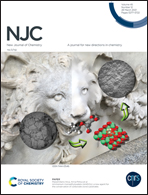Regulating the electronic properties of MoSe2 to improve its CO2 electrocatalytic reduction performance via atomic doping†
Abstract
Reduction of carbon dioxide (CO2) to energy-rich hydrocarbons by electrocatalysis due to the high bond energy of C![[double bond, length as m-dash]](https://www.rsc.org/images/entities/char_e001.gif) O is a great challenge. To clearly understand the mechanism of CO2 reduction at the electronic scale, through density functional theory (DFT) calculations, the pathways of the CO2 reduction reaction on two-dimensional (2D) MoSe2 doped transition metals (Fe, Co, Ni and Cu) are explored. The obtained results show that NiMT@MoSe2, CuH@MoSe2 and CuMT@MoSe2 are suitable for CO2 reduction, which may be attributed to the moderate CO2 adsorption energies and influence of regulated electronic properties. Cu doped MoSe2 has excellent performance for methane (CH4) production with lower limiting potentials. Our findings greatly contribute to a comprehensive understanding of the influencing electronic properties on CO2 reduction and CH4 selectivity, which provides significant guidance for further CO2 reduction reaction catalyst design at an atomic level.
O is a great challenge. To clearly understand the mechanism of CO2 reduction at the electronic scale, through density functional theory (DFT) calculations, the pathways of the CO2 reduction reaction on two-dimensional (2D) MoSe2 doped transition metals (Fe, Co, Ni and Cu) are explored. The obtained results show that NiMT@MoSe2, CuH@MoSe2 and CuMT@MoSe2 are suitable for CO2 reduction, which may be attributed to the moderate CO2 adsorption energies and influence of regulated electronic properties. Cu doped MoSe2 has excellent performance for methane (CH4) production with lower limiting potentials. Our findings greatly contribute to a comprehensive understanding of the influencing electronic properties on CO2 reduction and CH4 selectivity, which provides significant guidance for further CO2 reduction reaction catalyst design at an atomic level.



 Please wait while we load your content...
Please wait while we load your content...